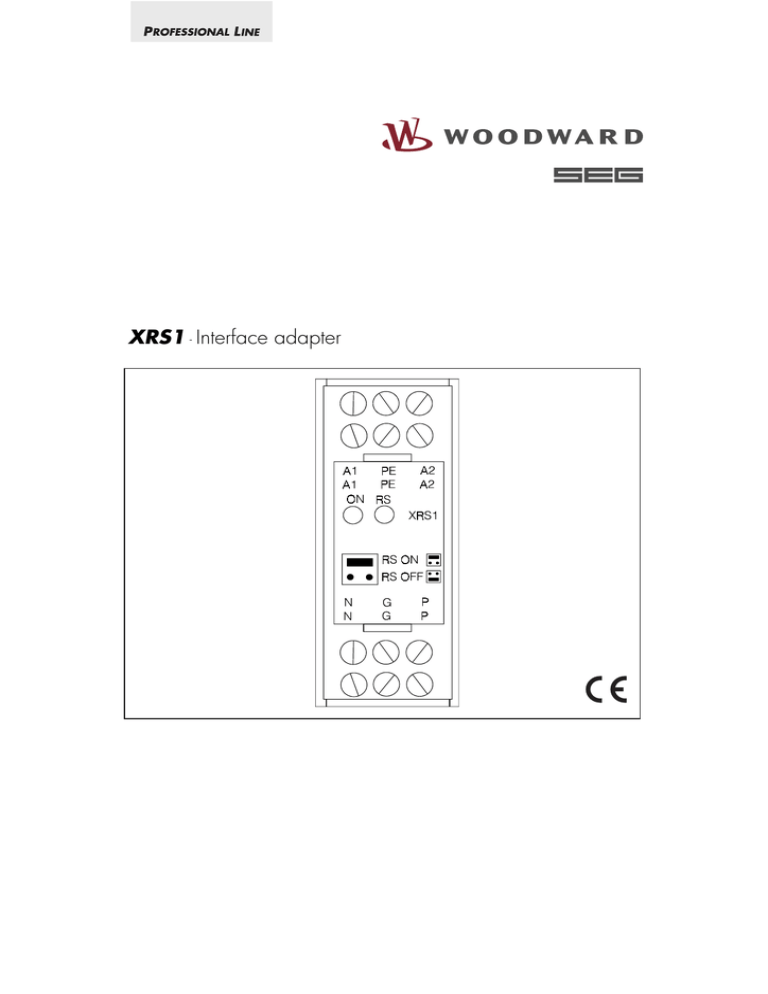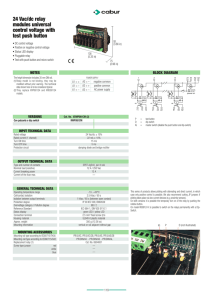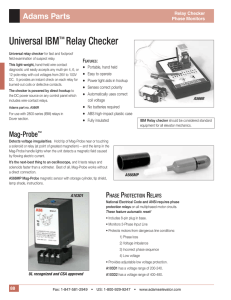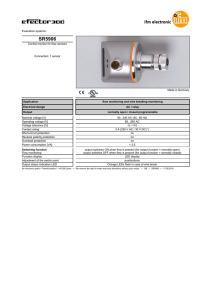XRS1 - DSF Technologies
advertisement

XRS1 - Interface adapter Contents 1. Applications and features 1. Applications and features 2. Design 3. Function 3.1 Bus structure and line terminator 4. Operation and settings For communication between relays and master system the interface adapter XRS1 is available for data transmission, inclusive the relevant software. This latterally at the relay arranged adapter can easily be retrofitted and be installed without problems. Galvanic isolation from the relay is realized by means of optical transmission and so the latest measuring values can be read-out, relay parameters set and protection functions for the output relays configurated. 5. Relay case and technical data 5.1 Relay case 5.2 SUB-D plug, 9-pin 5.3 Technical data Fig. 1.1: Communication via serial interface adapter When compared to the conventional protection equipment all relays of the PROFESSIONAL LINE reflect the superiority of digital protection techniques with the following features: • High measuring accuracy by digital data processing • Fault indication via LEDs • Wide operating ranges of the supply voltage by universal wide-range power supply • Very fine graded wide setting ranges • Extremely short response time • Compact design by SMD-technology 2 TB XRS1 07.97 E 2. Design Auxiliary voltage supply Interface adapter XRS1 or XRS1-A need a separate auxiliary voltage supply. Therefore a DC voltage must be used.. Units XRS1 or XRS1-A have an integrated power supply. Voltages in the range from 19 - 55 V DC can be applied at connection terminals A1 and A2. Terminals A1 - A2 PE N = RxD/TxD-N P = RxD/TxD-P Supply voltage Earth connection for screened data line Signal line, Data - (converter) Signal line, Data + (converter) Fig. 2.1: Connection diagram Note: All terminals for the interface module are provided twice so if there are several devices in use, the cables can be lead through. Fig. 2.2: Connection diagram line terminator relay XRS1-A TB XRS1 07.96 E 3 3. Working Principle Communication between PROFESSIONAL LINE relays and master system is done via interface adapter XRS1. The adapter is arranged laterally to PROFESSIONAL LINE relays (see fig. 1.1). Galvanically decoupling from the relay is realized by means of optical transmission in form of IR-LEDs. The following diagram shows an connection example of three XRS1 inclusive master. Fig. 3.1: Connection example 3 devices + master 3.1 Bus structure and line terminator Fig. 3.2: Bus structure Fig. 3.3: Relay XRS1-A mit line terminator 4 TB XRS1 07.97 E 4. Operation and settings All indication elements as well as the coding plug for activating the interface module are at the front of the XRS1. Because of this all adjustments of the unit can be made or changed without disconnecting the unit off the DINrail. Slave address setting of all PROFESSIONAL LINE relays (exception XM1) 1. 2. 3. 4. Switch on auxiliary voltage. DIP-switch 1 - 3 of the protection relay must be switched to "ON" position. All potentiometer must be turned to the right position. The slave address can be set with the the aid of DIP-switch 4 - 8: DIP-switch Value 4 0 2 5 1 2 6 2 2 7 3 2 8 4 2 Setting example Slave address 11 should be set. For this DIP-switch 4, 5 and 7 must be switched to "ON" position. 5. 6. Next <TEST> push button must be pressed for about 1 s. Last of all the potentiometer and DIP-switches must be set to the corresponding protection threshold values. Slave address setting of XM1 relays 1. 2. Switch off auxiliary voltage supply. The slave address can be set with the the aid of DIP-switch 1 - 5: DIP-switch Value Fig. 4.1: Front plate LEDs LED „ON“ is used for display of the readiness for service (at applied auxiliary voltage Uv). Die LED RS flashes during data transmission from slave (and plug RS in position „ON“). RS plug 1 0 2 2 1 2 3 2 2 4 3 2 5 4 2 Setting example: Slave address 11 should be set. For this DIP-switch 1, 2 and 4 must be switched to "ON" position. 3. 4. 5. DIP-switch 7 must be switched to "OFF" position. DIP-switch 8 however to "ON" position. Switch on power supply and press the <Test> key. (LEDs light up for a moment). Switch off the aux. voltage supply again. DIPswitch 8 must be switched to OFF position. Last of all the DIP-switches must be set to the corresponding protection threshold values. When plug RS is in position "ON", the interface module is activated; in position "OFF" there is no data transmission via the blocked module possible. The data bus, however, is active for any other devices connected. TB XRS1 07.96 E 5 5. Relay case and technical data 5.1 Relay case Relay XRS1 is designed to be fastened onto a DIN-rail acc. to DIN EN 50022, the same as all units of the PROFESSIONAL LINE. Fig. 5.1: Dimensional drawing Connection terminals 2 The connection of up to a maximum 1 x 1.5 mm cross-section conductors is possible. 5.2 SUB-D plug, 9-pin Fig. 5.2: Contacts used by a 9-pin SUB-D plug for connection between XRS1 and master 6 TB XRS1 07.97 E 5.3 Technical data Electrical feature: Transmission line: RS485 galvanically decoupled via optical transmission line (lateral IR-LEDs) max. 1000 m Transmission mode: Number of devices: End device: screened 2-wire bus, semi-duplex, 9600 bit, master-slave principle 1 master, 32 slaves Relay XRS1-A (line terminators for data line in the device) Auxiliary voltage Rated auxiliary voltage Uv/ Power consumption: 19 - 55 V DC / 4 W (terminals A1 and A2) System data Regulations: VDE 0160; VDE 0871 Temperature range at storage and operation: -25°C to +70°C Constant climate class F acc. DIN 40040 and DIN IEC 68, part 2-3: more than 56 days at 40°C and 95 % relative humidity Radio interference suppression test as per DIN 57871 and VDE 0871: limit value class A Mechanical test: Shock: Vibration: class 1 acc. to DIN IEC 255-21-2 class 1 acc. to DIN IEC 255-21-1 Degree of protection Front plate: Weight: Mounting position: IP40 at closed front cover approx. 0.125 kg any Technical data subject to change without notice! TB XRS1 07.96 E 7 Woodward SEG GmbH & Co. KG Krefelder Weg 47 ⋅ D – 47906 Kempen (Germany) Postfach 10 07 55 (P.O.Box) ⋅ D – 47884 Kempen (Germany) Phone: +49 (0) 21 52 145 1 Internet Homepage http://www.woodward-seg.com Documentation http://doc.seg-pp.com Sales Phone: +49 (0) 21 52 145 635 ⋅ Telefax: +49 (0) 21 52 145 354 e-mail: kemp.electronics@woodward.com Service Phone: +49 (0) 21 52 145 614 ⋅ Telefax: +49 (0) 21 52 145 455 e-mail: kemp.pd@woodward.com



